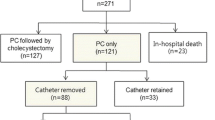Abstract
Background
Acute calculous cholecystitis is a frequently encountered problem in surgical practice; laparoscopic cholecystectomy (LC) is the standard treatment. LC for acute cholecystitis can be a more difficult procedure than elective LC for cholelithiasis and is associated with increased operating time, higher conversion rate, and more postoperative complications. In the elderly patient with comorbidity, surgery can result in serious complications and even mortality. Percutaneous drainage (percutaneous cholecystostomy; PC) may be an alternative treatment. There is no hard evidence in current literature regarding the safety, success rate, and specific technique of this procedure, nor is there consensus on the indications.
Aim
To evaluate the safety and efficacy of PC in treatment of acute calculous cholecystitis in high-risk surgical patients.
Methods
From January 2009 until May 2010, 101 patients with acute calculous cholecystitis were treated, of whom 27 with PC. Of these 27 patients, comorbidity and American Society of Anesthesiologists (ASA) classification were determined, indication for drainage instead of cholecystectomy was recorded, and procedure-related data were collected. Primary outcomes were overall morbidity, mortality, and recurrent biliary events. Secondary outcomes were time to recovery and need for and difficulty of interval laparoscopic cholecystectomy.
Results
The cohort included 15 male and 12 female patients with median age of 83 years (range 69–90 years). Most patients were ASA 3 (n = 18) or ASA 2 (n = 8); one patient was ASA 4. Indication for drainage was age and/or comorbidity in 24 cases and duration of symptoms in 3 cases. Antibiotic treatment was given in all but seven patients. The drain was in situ for a median period of 19 days (range 5–57 days). Relief of symptoms occurred in 26 patients; drain luxation occurred in nine patients, only in two patients with clinical consequences. Overall mortality rate was 14.8% (n = 4) with a procedure-related mortality rate of 3.7%. Median time to full recovery was 8 days. With median follow-up of 8 weeks, four patients underwent interval cholecystectomy.
Conclusions
Percutaneous drainage in acute calculous cholecystitis in high-risk patients seems to be a safe and successful treatment option in patients less eligible for surgery. There are many controversies in the current literature, and evidence-based guidelines for the indication of PC in treatment of acute calculous cholecystitis are needed.
Similar content being viewed by others
References
Keus F, Gooszen HG, van Laarhoven CJ (2010) Open, small-incision, or laparoscopic cholecystectomy for patients with symptomatic cholecystolithiasis. An overview of Cochrane Hepato-Biliary Group reviews. Cochrane Database Syst Rev (1): CD008318
Pessaux P, Regenet N, Tuech JJ, Rouge C, Bergamaschi R, Arnaud JP (2001) Laparoscopic versus open cholecystectomy: a prospective comparative study in the elderly with acute cholecystitis. Surg Laparosc Endosc Percutan Tech 11:252–255
Bingener J, Richards ML, Schwesinger WH, Strodel WE, Sirinek KR (2003) Laparoscopic cholecystectomy for elderly patients: gold standard for golden years? Arch Surg 138:531–535
Decker G, Goergen M, Philippart P, Mendes da CP (2001) Laparoscopic cholecystectomy for acute cholecystitis in geriatric patients. Acta Chir Belg 101:294–299
Kirshtein B, Bayme M, Bolotin A, Mizrahi S, Lantsberg L (2008) Laparoscopic cholecystectomy for acute cholecystitis in the elderly: is it safe? Surg Laparosc Endosc Percutan Tech 18:334–339
Winbladh A, Gullstrand P, Svanvik J, Sandstrom P (2009) Systematic review of cholecystostomy as a treatment option in acute cholecystitis. HPB (Oxford) 11:183–193
Kauvar DS, Brown BD, Braswell AW, Harnisch M (2005) Laparoscopic cholecystectomy in the elderly: increased operative complications and conversions to laparotomy. J Laparoendosc Adv Surg Tech A 15:379–382
Brunt LM, Quasebarth MA, Dunnegan DL, Soper NJ (2001) Outcomes analysis of laparoscopic cholecystectomy in the extremely elderly. Surg Endosc 15:700–705
http://nvvh.artsennet.nl/Kwaliteit/richtlijnen/Bestaande-richtlijnen.htm. 5 Apr 2011
Hatzidakis AA, Prassopoulos P, Petinarakis I, Sanidas E, Chrysos E, Chalkiadakis G, Tsiftsis D, Gourtsoyiannis NC (2002) Acute cholecystitis in high-risk patients: percutaneous cholecystostomy vs conservative treatment. Eur Radiol 12:1778–1784
Hirota M, Takada T, Kawarada Y, Nimura Y, Miura F, Hirata K, Mayumi T, Yoshida M, Strasberg S, Pitt H, Gadacz TR, de Santibanes E, Gouma DJ, Solomkin JS, Belghiti J, Neuhaus H, Buchler MW, Fan ST, Ker CG, Padbury RT, Liau KH, Hilvano SC, Belli G, Windsor JA, Dervenis C (2007) Diagnostic criteria and severity assessment of acute cholecystitis: Tokyo guidelines. J Hepatobiliary Pancreat Surg 14:78–82
Chok KS, Chu FS, Cheung TT, Lam VW, Yuen WK, Ng KK, Chan SC, Poon RT, Yeung C, Lo CM, Fan ST (2010) Results of percutaneous transhepatic cholecystostomy for high surgical risk patients with acute cholecystitis. ANZ J Surg 80:280–283
Leandros E, Alexakis N, Archontovasilis F, Albanopoulos K, Dardamanis D, Menenakos E, Tsigris C, Giannopoulos A (2007) Outcome analysis of laparoscopic cholecystectomy in patients aged 80 years and older with complicated gallstone disease. J Laparoendosc Adv Surg Tech A 17:731–735
Yi NJ, Han HS, Min SK (2006) The safety of a laparoscopic cholecystectomy in acute cholecystitis in high-risk patients older than sixty with stratification based on ASA score. Minim Invasive Ther Allied Technol 15:159–164
Hatjidakis AA, Karampekios S, Prassopoulos P, Xynos E, Raissaki M, Vasilakis SI, Gourtsoyiannis NC (1998) Maturation of the tract after percutaneous cholecystostomy with regard to the access route. Cardiovasc Intervent Radiol 20:36–40
Loberant N, Notes Y, Eitan A, Yakir O, Bickel A (2010) Comparison of early outcome from transperitoneal versus transhepatic percutaneous cholecystostomy. Hepatogastroenterology 57:12–17
Disclosures
Authors Kortram, de Vries Reilingh, Wiezer, van Ramshorst, and Boerma have no conflicts of interest or financial ties to disclosure.
Author information
Authors and Affiliations
Corresponding author
Rights and permissions
About this article
Cite this article
Kortram, K., de Vries Reilingh, T.S., Wiezer, M.J. et al. Percutaneous drainage for acute calculous cholecystitis. Surg Endosc 25, 3642–3646 (2011). https://doi.org/10.1007/s00464-011-1771-5
Received:
Accepted:
Published:
Issue Date:
DOI: https://doi.org/10.1007/s00464-011-1771-5




